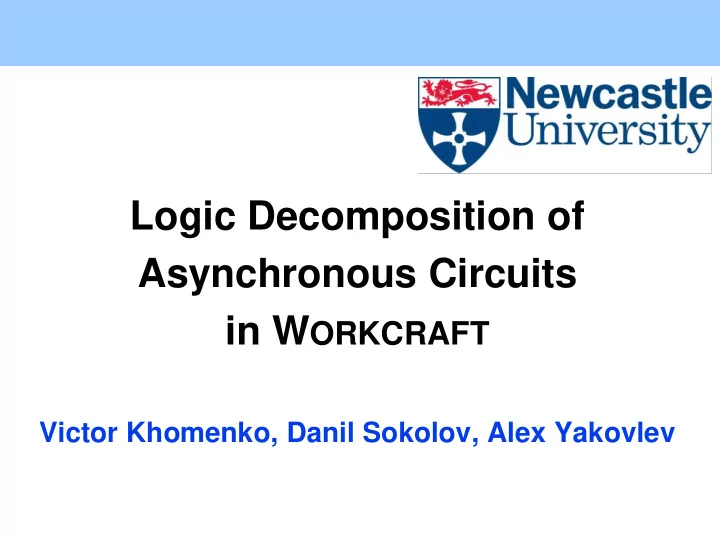

Logic Decomposition of Asynchronous Circuits in W ORKCRAFT Victor Khomenko, Danil Sokolov, Alex Yakovlev
Motivation • Logic decomposition is one of the most difficult tasks in the design flow • Much more difficult than for synchronous circuits – no guarantee of success • The quality of the resulting circuit (in terms of area and latency) depends to a large extent on the way logic decomposition was performed 2
Speed-independency assumptions • Gates are atomic (so no internal hazards) F … delay instant evaluator • Gates’ delays are positive and unbounded (and perhaps variable) • Wire delays are negligible (SI) or, alternatively, wire forks are isochronic (QDI) 3
Speed-independent decomposition F … delay instant evaluator H 1 delay … G … delay H k delay … 4
VME Bus Controller Data Transceiver Bus Device d lds dsr VME Bus ldtack dtack Controller dtack- dsr+ csc+ lds+ d- lds- ldtack- ldtack+ csc- dsr- dtack+ d+ 5
Complex-gate implementation Data Transceiver Bus d lds Device dtack dsr csc ldtack May be not in the gate library and has to be decomposed 6
Naïve decomposition is hazardous dtack- dsr+ csc+ lds+ d- lds- ldtack- ldtack+ csc- dsr- dtack+ d+ d lds dtack Unexpected! dsr Unexpected! csc x ldtack 7
Decompose at the level of STG dtack- dsr+ csc+ lds+ ldtack+ d- lds- ldtack- dec+ dec- csc- dsr- dtack+ d+ d lds dtack Insert a new signal dec whose Multiway acknowledgement implementation is [dec] = ldtack + csc dsr csc dec ldtack 8
Latch utilisation d d lds lds dtack dtack dsr dsr csc csc C ldtack ldtack Only possible because there is no globally reachable state at which dsr=ldtack=0 and csc=1 9
Logic decomposition algorithm • Synthesise the circuit from the STG (several complex-gate and standard-C implementations are considered for each signal) • Heuristically select a non-mappable gate, and a decomposition of this gate • Insert a new signal into the STG for the sub- function in the selected decomposition • Repeat the above steps until all gates are mappable or no further progress is possible 10
Function-guided signal insertion Problem: given a Boolean function F, insert a new signal dec (i.e. a set of new transitions labelled dec+ or dec-) with the implementation [dec]=F into the STG 11
Transition insertions Sequential pre-insertion Sequential post-insertion Concurrent insertion 12
Example: imec-sbuf-ram-write dec+ imec-sbuf-ram-write req prbar wen precharged wsen done ack wsldin wsld wenin dec- Implementation of prbar: (csc2 req) csc1 wsldin dec 13
Generalised transition insertion s 1 d 1 sources destinations s 2 d 2 s 3 Sources and destinations are locked 14
Cost function Parameterised by the user; takes into account: • the delay introduced by the insertion • the number of syntactic triggers of all non- input signals • the number of inserted transitions of a signal • the number of signals which are not locked with the newly inserted signal • … 15
Overcoming mapping failure • Logic decomposition is not guaranteed to succeed, so tools occasionally fail • May need to help the tools: ▪ methods & tricks ▪ “think outside the box” – knowledge of the environment, capacity to redesign the system and its environment ▪ “high - level understanding of the design” – knowing the causal dependencies between the signals, which environment signals are fast/slow (useful for concurrency reduction), etc. ▪ relative timing assumptions 16
0 Prevention is better than cure • Large monolithic STGs are difficult, both for humans and for tools • Hierarchical design: ▪ architectural decomposition into modules ▪ … until each module is small, say ~10 signals (this size is about right for humans * and tools) ▪ Advantages: human- and tool-friendly, more predictable, module re-use (within and between designs), easy to document and maintain, etc. • Workcraft has support for hierarchical designs 17
Example: stage of multiphase buck 18
1 Expanding gate library • Add a missing gate to the library • Usually not an option 19
2 Inserting a useful signal • Tools often fail because: ▪ some heuristic selects a bad sub-function ▪ there is no structural signal insertion to implement a useful sub-function • One can help the tool by inserting an internal signal implementing a useful sub-function 20
Example: OR5 21
3.1 Simplifying the STG structure • If the STG has complicated structure, it may be impossible to insert a signal structurally (e.g. one would have to merge and then split some choice branches for that) • Try to simplify the STG structure by reducing the number of choice and merge (i.e. explicit) places, in particular controlled choices can often be removed 22
Example: OR5 23
3.2 STG re-synthesis • Re-synthesis builds the state graph and then derives an equivalent STG from it, often with simpler structure • Fully automatic, so easy to try if technology mapping fails • Try various command-line options 24
4 Concurrency reduction • CR does not necessarily decrease performance – though events are less concurrent, the gates become smaller and some internal signals may become unnecessary • CR may change the contract with the environment and introduce a deadlock or global deterioration of performance that is difficult to debug 25
Example: xyz 26
Example: xyz with CR 27
Example: xyz with more CR 28
5 Relative timing assumptions • Occasionally, the described techniques still fail to yield a solution • Breaking up a large gate yields a non-speed- independent decomposition • The correct operation can then be ensured by relative timing assumptions • This has implications for place&route • Easy to make a mistake, need tool support 29
Example: VME read phase MaxDelay(x-) < MinDelay(d- → lds-) MaxDelay(x-) < MinDelay(d- → dtack- → dsr+) 30
Thank you! Any questions? 31
Recommend
More recommend